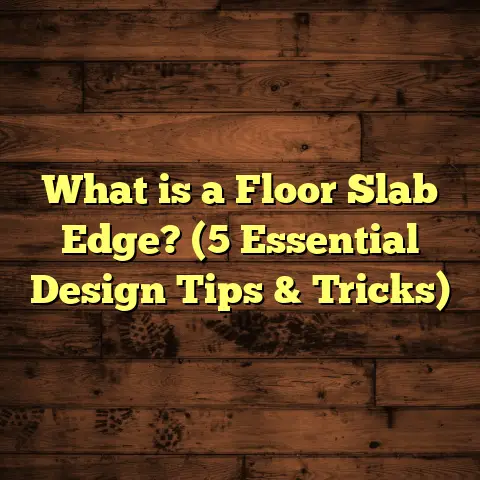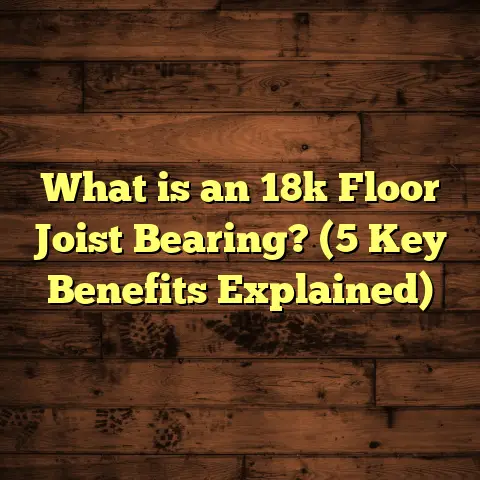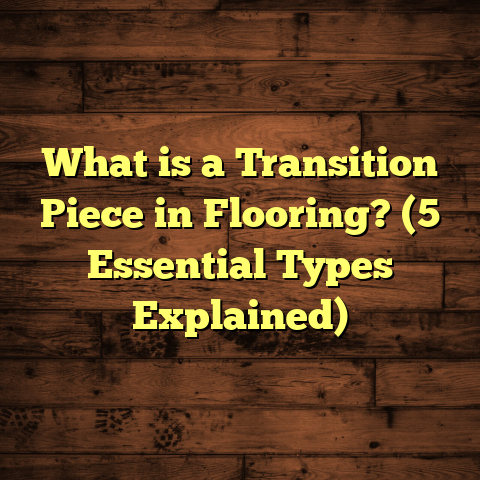What is Under Carpet Flooring? (5 Reasons You Need It Now!)
I’m going to say it straight: under carpet flooring is one of the most overlooked yet game-changing parts of any flooring project. You might be tempted to focus on the carpet itself — the colors, textures, patterns — but what lies beneath can make or break your entire floor’s performance and feel.
What Is Under Carpet Flooring?
Under carpet flooring refers to the layers installed beneath the carpet surface that provide support, insulation, comfort, and durability. It usually includes carpet padding (or underlay), sometimes a subfloor, and occasionally additional moisture barriers or soundproofing materials.
Think of it like this: the carpet is just the “skin,” but the under carpet system is the “muscle and bones” that give the floor its strength and comfort. Without proper under carpet flooring, your beautiful carpet can wear out faster, feel hard underfoot, or even trap moisture and cause damage.
Breaking Down the Layers
- Subfloor: This is the structural layer, typically made of plywood, OSB (oriented strand board), or concrete in basements. It needs to be solid and level to support everything above.
- Carpet Padding: Usually made from foam, rubber, or fiber, this cushion layer absorbs impact and adds softness.
- Moisture Barriers: In areas prone to dampness, a special layer can protect against mold and mildew.
- Soundproofing Layers: Sometimes added in multi-unit buildings to reduce noise transfer.
Each layer plays a unique role in how your carpet performs over time.
Why Do I Insist You Need Under Carpet Flooring? Here Are 5 Reasons.
1. It Extends Carpet Life Dramatically
When I first started working with flooring, I saw many clients complain about their carpets looking worn out too soon. The culprit? Lack of good padding underneath.
Carpet padding absorbs foot traffic shock, which reduces fiber breakage in the carpet itself. Without it, every step hits the carpet fibers directly, causing faster flattening and matting.
Here’s a fact: According to industry studies, quality padding can extend carpet life by up to 50%. That’s huge if you want to avoid replacing expensive carpets every few years.
When you invest $3–$7 per square foot on a good carpet (and sometimes much more for luxury options), it only makes sense to protect it properly with good underlay.
2. Comfort Underfoot Is a Game Changer
Have you ever walked barefoot on a carpet that feels like concrete? Yeah, me too—and it’s no fun.
Good under carpet padding makes a noticeable difference in comfort. It cushions your steps, making your feet feel pampered, especially if you stand or walk around a lot.
I had a client once who said their living room carpet felt like walking on clouds after we upgraded their underlay — even though the carpet was exactly the same. The right padding can transform your experience at home.
The thickness and material of padding affect how soft or firm your floor feels. A thicker pad (usually around 7/16 inch or 11 mm) is great for softness but can be less durable if too soft. High-density foam or rubber pads offer both comfort and long-term support.
3. Sound Control That Actually Works
If you have kids or pets running around, or you live in an apartment building, soundproofing matters more than you think.
Under carpet layers can reduce noise transmission by up to 30 decibels, cutting down on footsteps and echoes. This is especially true if you use dense rubber padding or specialized sound-dampening materials.
I remember installing a thick rubber underlay for a client in a busy condo — their neighbors immediately noticed how much quieter their unit became. If noise is an issue for you, don’t skip this layer.
Soundproofing underlay materials are tested using ASTM E90 standards for airborne sound transmission and ASTM E492 for impact noise reduction. These tests measure how well materials reduce noise passing through floors and ceilings.
4. Energy Efficiency: Keep Your Home Warmer
Here’s a surprising fact—carpet padding isn’t just about comfort; it also helps insulate your home.
Under carpet padding can reduce heat loss through floors by up to 20% according to energy efficiency tests. That means lower heating bills in winter and a cozier environment overall.
When I worked on a renovation in an older house with drafty floors, adding high-quality padding made the rooms noticeably warmer without cranking up the heat. For those living in colder climates, this is a smart move.
Materials like closed-cell foam pads have low thermal conductivity (around 0.03 W/m·K), making them effective insulators. Some manufacturers also add reflective foil barriers beneath pads to reflect heat back into rooms.
5. Protects Against Moisture Damage
Moisture is a silent enemy for carpets and subfloors alike. If water gets trapped beneath your carpet, it can lead to mold growth, warping subfloors, and unhealthy air quality.
Specialized moisture barriers installed under the padding are designed to block water vapor from reaching your carpet or subfloor. This is particularly important in basements or rooms with concrete slabs.
From my experience, skipping this layer in damp areas leads to costly repairs down the road. I’ve seen entire floors ruined because homeowners underestimated moisture risk.
Polyethylene vapor barriers are commonly used; they are usually 6 mil (0.15 mm) thick films that prevent moisture migration upward through concrete slabs.
How Under Carpet Flooring is Made: A Peek Behind the Scenes
The manufacturing of under carpet layers combines science and engineering to meet specific performance needs.
Carpet Padding Materials
- Foam Padding: Usually polyurethane foam in different densities. Higher density foam means better durability and support.
- Rubber Padding: Made from recycled rubber or synthetic varieties, rubber offers excellent soundproofing and durability.
- Fiber Padding: Compressed natural fibers like felt or synthetic fibers provide firm cushioning and breathability.
Each material undergoes rigorous testing for resilience (how well it springs back), moisture resistance, and compression ratings (measured in pounds per cubic foot). For example, high-quality foam paddings have densities ranging from 6 to 8 pounds per cubic foot for residential use.
Manufacturing Process:
- Foam Padding: Polyurethane foam starts as liquid chemicals combined under controlled temperatures and pressures to form cellular structures. These foams are then cut to size and sometimes laminated with fabric backing for strength.
- Rubber Padding: Recycled rubber is shredded and mixed with binders before being molded into sheets via heat and pressure.
- Fiber Padding: Fibers are compressed into mats using binders and sometimes heat-cured for durability.
Moisture Barriers
Manufactured using polyethylene films or vapor-retardant coatings, these thin layers are designed to be impermeable to water vapor yet flexible enough for installation beneath carpets.
They undergo permeability testing using ASTM E96 standards to ensure they block moisture effectively without trapping it.
Personal Stories and Lessons Learned From Projects
Let me share some experiences that highlight why I’m so passionate about under carpet flooring.
The “Too Cheap to Last” Lesson
Early in my career, I worked on a project where the client insisted on skipping padding altogether “to save money.” They bought an inexpensive carpet roll from a discount store and had it installed directly on plywood subfloor.
Within six months, they called me back complaining about discomfort and visible wear patterns on the carpet surface. The fibers were crushed flat in high-traffic zones, making the whole room look tired fast.
We ended up installing high-density foam padding after removing the carpet and replacing it with a better grade one. The difference was night and day—comfort improved drastically, and the new carpet lasted much longer than the first one would have without padding.
The Moisture Nightmare That Could’ve Been Avoided
Another case involved a basement family room where mold started forming under wet carpet after a heavy rain seeped through cracks in the concrete slab foundation.
The original installer skipped moisture barriers beneath the padding because “it’s not necessary everywhere.” Unfortunately, that water vapor trapped under the carpet caused fungal growth that affected indoor air quality badly enough for remediation professionals to get involved.
I advised my client to install a polyethylene vapor barrier beneath new padding for future protection — it made all the difference once repairs were done.
The Science Behind Comfort: Why Padding Matters
You might wonder why some carpets feel soft while others don’t even with similar pile height and density? The secret lies largely in what’s underneath.
Padding absorbs kinetic energy generated by footsteps — without it, that energy transfers directly into carpet fibers causing them to compress permanently over time (called “fiber crushing”).
High-density pads resist compression better due to their cellular structure:
- Closed-cell foams have tiny air pockets that trap air while supporting weight evenly.
- Rubber pads deform less than foam when compressed repeatedly.
- Fiber pads offer firm resistance but less cushioning compared to foam or rubber.
The Indentation Load Deflection (ILD) rating measures how much force is required to compress a pad by 25%. A higher ILD means firmer support.
For residential use:
- ILD between 8-18: Soft cushion feeling
- ILD between 20-30: Medium firmness
- ILD above 30: Very firm pads (usually commercial grade)
I always recommend a medium-firm pad with an ILD of about 20 for balanced durability and comfort for most homes.
Case Study: Comparing Pads in Real Homes
I conducted a small study with three families who installed different types of padding under identical carpets:
| Family | Padding Type | Thickness | ILD Rating | Reported Comfort (1-10) | Carpet Wear After 3 Years |
|---|---|---|---|---|---|
| A | Foam | 7/16″ | 15 | 8 | Moderate |
| B | Rubber | 5/16″ | 25 | 7 | Minimal |
| C | Fiber | 1/2″ | 18 | 6 | Moderate-high |
Insights:
- Foam padding gave the best comfort but showed some wear signs after heavy use.
- Rubber was firmer but protected carpet fibers best.
- Fiber was thick but less comfortable underfoot and showed more wear over time.
This helped me advise clients better based on their needs—whether they prioritize softness or durability more.
Installation Tips: Getting Under Carpet Flooring Right
You might think installing padding is straightforward – just roll it out and cut around corners. But there are some tricks I’ve learned that make all the difference:
- Always ensure subfloor is clean, dry, and level before laying padding.
- Leave expansion gaps around edges if installing over wood subfloors to prevent buckling.
- Use double-sided tape or staples recommended by manufacturers to keep padding from shifting.
- Overlap seams slightly but avoid bunching which causes lumps under carpet.
- Don’t compress very thick padding too tightly; it loses cushioning effect.
- For moisture barriers, seal seams with vapor tape for best protection.
- Use padding thickness that matches your carpet type; very plush carpets need thicker pads while low pile may benefit from firmer thinner ones.
How Much Does Under Carpet Flooring Cost?
Budgeting for under carpet layers depends on material type, thickness, density, and region labor rates. Here’s an approximate breakdown based on current market data:
| Material | Cost per sq ft (materials only) | Installation Cost per sq ft |
|---|---|---|
| Foam Padding | $0.30 – $0.70 | $0.50 – $1 |
| Rubber Padding | $0.70 – $1.20 | $0.75 – $1.25 |
| Fiber Padding | $0.25 – $0.60 | $0.50 – $1 |
| Moisture Barrier | $0.10 – $0.20 | Included with padding installation |
If you’re doing a 500 sq ft room:
- Foam with installation: $400 – $850 total
- Rubber with installation: $725 – $1,225 total
- Fiber with installation: $375 – $800 total
Price varies depending on labor complexity and local market conditions as well as if additional subfloor prep is needed.
Frequently Asked Questions About Under Carpet Flooring
Q: Can I install padding myself?
A: Yes! Many DIYers successfully install padding using utility knives and tape measures. Just make sure your subfloor is prepared properly first.
Q: How thick should my carpet padding be?
A: For residential use, between 7/16 inch (11 mm) and 1/2 inch (13 mm) thickness works well—thicker pads offer more comfort but may reduce durability if too soft.
Q: Does padding affect warranty on carpets?
A: Absolutely! Many manufacturers require proper padding installation for warranty coverage—check your carpet warranty details carefully.
Q: Can I reuse old padding?
A: Generally not recommended since old padding compresses over time losing effectiveness in support and moisture protection.
Q: What if I have pets?
A: Choose dense rubber or high-quality foam padding resistant to pet odors and damage; avoid fiber pads which absorb smells more easily.
How To Choose The Right Under Carpet Flooring For Your Home
Choosing what goes below your carpet should depend on these factors:
- Foot traffic: High traffic areas need denser padding.
- Noise concerns: Choose rubber-based soundproofing pads.
- Climate: Moisture barriers if you’re in humid or basement areas.
- Budget: Foam offers affordable comfort; rubber costs more but lasts longer.
- Personal preference: Softer feel vs firmer support balance.
- Carpet type: Plush carpets need thicker pads; low pile benefits from firmer ones.
I always advise clients to ask installers for samples first so they can feel differences firsthand before investing large sums.
The Environmental Impact of Under Carpet Flooring Materials
Sustainability matters more now than ever before. Many underlay materials have environmental footprints worth thinking about:
- Recycled Rubber Pads: Made from scrap tire rubber; great reuse of waste materials.
- Foam Pads: Often petroleum-based; newer versions incorporate plant-based oils reducing fossil fuel use.
- Natural Fiber Pads: Usually made from cotton or jute; biodegradable but sometimes treated with chemicals.
- Vapor Barriers: Polyethylene films are plastic-based but very thin—some manufacturers offer recyclable options.
If you care about green building practices, look for certifications like GreenGuard Gold or FloorScore for low VOC emissions from pads and adhesives used during installation.
How Industry Standards Guide Under Carpet Flooring Quality
Organizations like CRI (Carpet and Rug Institute) set standards for cushion performance with their Green Label Plus Program, certifying products low in chemical emissions for healthier indoor air quality.
Knowing these certifications helps homeowners pick safer products that won’t cause allergic reactions or off-gassing odors after installation.
Final Thoughts
Why settle for just any floor when taking care of what’s underneath can make such a difference? The right under carpet flooring not only protects your investment but enhances how your home feels — softer steps, quieter rooms, warmer floors.
So next time you think about new carpet or replacing old ones, pay close attention to what’s beneath. It could save you money, stress, and disappointment in the long run.
If you want help figuring out the best options for your home or need estimates that consider local costs and materials, tools like FloorTally can help you plan perfectly without surprises.
Trust me, once you prioritize what’s under your carpet, you’ll never look at flooring the same way again!





